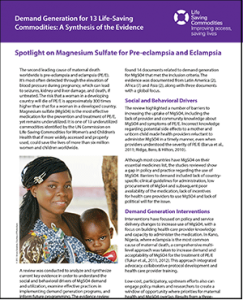Spotlight on Magnesium Sulfate for Pre-eclampsia and Eclampsia
The risk that a woman in a developing country will die of PE/E is approximately 300 times higher than that for a woman in a developed country. Magnesium sulfate (MgSO4) is the most effective medication for the prevention and treatment of PE/E, yet remains underutilized. It is one of 13 underutilized commodities identified by the UN Commission on Life-Saving Commodities for Women’s and Children’s Health that if more widely accessed and properly used, could save the lives of more than six million women and children worldwide. The second leading cause of maternal death worldwide is pre-eclampsia and eclampsia (PE/E). It’s most often detected through the elevation of blood pressure during pregnancy, which can lead to seizures, kidney and liver damage, and death, if untreated.


 This website is made possible by the support of the American People through the
This website is made possible by the support of the American People through the